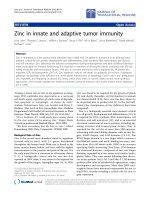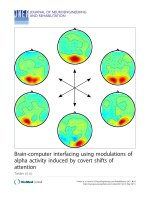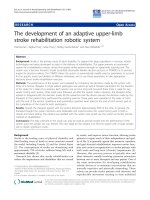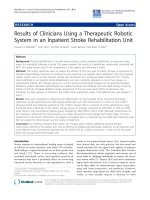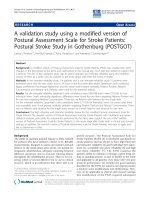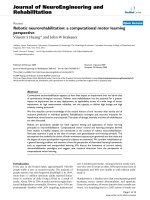Báo cáo hóa học: " Automated traffic engineering using adaptive inter-class mixing" pdf
Bạn đang xem bản rút gọn của tài liệu. Xem và tải ngay bản đầy đủ của tài liệu tại đây (474.83 KB, 9 trang )
RESEARCH Open Access
Automated traffic engineering using adaptive
inter-class mixing
Muhammad Salman Zafar
1*
, Junaid Zubairi
2
and Aasia Khanum
1
Abstract
Traffic engineering (TE) optimizes the performance of a network by analyzing and regulating the data transmission.
Traffic engineering with link coloring (TELIC) was proposed to automatically assign LSPs in multi-protoco l label
switching domain based on bandwidth and class of service attributes. TELIC dynamically assigns colors to links in
the network domain on the basis of reservable bandwidth. Different classes of traffic are entitled for using different
colored links. The main contribution of TELIC is segregation of premium and non-premium traffic results in
predictable service for premium traffic. After the introduction of TELIC, the Internet engineering task force
introduced two important bandwidth constraint models (BCM): maximum allocation model (MAM) and Russian
dolls model (RDM). MAM refers to segregation/isolation of class types (CTs) with no channel pre-emption, whereas
RDM refers to aggregation by allowing lower classes for using the bandwidth of higher class on availability and
pre-emption when required. CT segregation in TELIC is similar to MAM; however, the inherent feature of pre-
emption makes TELIC distinct from MAM. This article introduce s an RDM version of TELIC by providing controlled
traffic mixing by allowing lower classes to share the bandwidth of higher classes whenever possible. Conjunction
factor and conjunction threshold are used for controlling the traffic mix. New rule set for bandwidth allocation and
sharing are defined. Results show that RDM TELIC provides fair service to non-premium traffic without degrading
the service for premium classes, as compared to other shortest distance-based methods.
Keywords: TELIC, RDM, MPLS, MPLS-TE, Diffserv, QoS
1. Introduction
The penetration of broadband resulted in development
of numerous Internet applications moving the world
toward global sharing and cooperation. Various Inter-
net-enabled applications have been developed. Some of
them can process the request in batches like e-mails;
however, lot of applications requires real-time updates.
Some of such applications are stock-exchange databases,
online games, real-time multimedia exchange, and busi-
ness intelligent applications. Moreover, the entire next
generation telecommunication networking infrastructure
is being migrated to IP network. Owing to the heavy
usage of real-time Internet applications, it is desirable
that connectionless networks should be designed in
such a way that they work like connection-oriented
circuits with guaranteed bandwidth and compliance
with service level agreements (SLAs).
To cope with the emerging and most demanding
application requirements on Internet, different proto-
cols, compression techniques, and security architectures
have been developed. Internet engineering task force
(IETF) and different study groups are working on devel-
oping new protocols and standards to realize the neces-
sities of real-time applications. Among others, some
protocols have taken care of quantitative guarantees to
the flows like resource reservation protocol while some
have addressed the qualitative guarantees by defining
behavior aggregates (BA), e.g., Diffserv (differentiated
services architectures ) [1,2]. Multi-protocol label switch-
ing (MPLS) strikes the middle ground by providing label
switched paths (LSP)-based quality of service (QoS) fra-
meworks which ultimately implement traffic engineering
(TE)[3].
While MPLS aware Diffserv domains address require-
ments of QoS applications, TE issue of efficient
* Correspondence:
1
College of Electrical and Mechanical Engineering, National Universi ty of
Sciences & Technology (NUST), Islamabad, Pakistan
Full list of author information is available at the end of the article
Zafar et al. EURASIP Journal on Wireless Communications and Networking 2011, 2011:49
/>© 2011 Zafar et al; l icensee Spr inger. This is an Open Access article distributed under the terms of the Creative Commons Attribution
License ( http ://creativecommon s.org/licenses/by/2.0), which p ermits unrestricted use, distribution, and reproduction in any medium,
provided t he orig inal work is properly cited.
utilization of bandwidth and network resources still
remains a question. Traffic engineering with link color-
ing (TELIC) is an algorithm for automating the Traffic
TE process on MPLS aware Diffserv domains [4,5].
Determining LSPs for different classes of traffic trunks
based on dynamically determined prioritized link colors
is the core of TELIC. The link coloring scheme in
TELIC ensures that premium traffic does not have to
share the links with non-premium traffic. While this
segregation of traffic is good for premium traffic, it may
result in less than desirable allocation for non-prem ium
traffic on the account that premium traffic may be
under-utilizing the bandwidth allocated to it.
After the introduction of TELIC in 2002, IETF intro-
duced two important BCMs for Diffserv aware MPLS
domain [6]: maximum allocation model (MAM) and
Russ ian doll model (RDM). MAM refers to segreg ation/
isolation of class types (CTs) where different traffic
classes have dedicated channels with no channel pre-
emption. CT segregation in TELIC is similar to MAM;
however, the inherent feature of pre-emption in favor of
premium classes makes TELIC distinct from MAM.
RDM (RFC 4127) [6] refers to aggregation by allowing
lower classes to use the bandwidth of higher class on
availability with pre-emption when required. It can
move up to 64 different order aggregates or CTs; thanks
to 3 EXP bits in the shim header of MPLS and 3 bit
TOS field. Currently, TELIC defines no specific rules for
premium and non-premium classes to share the same
link.
This article presents an RDM version of TELIC by
introducing traffic mixing, i.e., lower classes can share
the bandwidth of higher classes whenever possible. Con-
junction factor (CF) and conjunction threshold are used
for controlling the mix of traffic on the links. New rule
sets for bandwidth allocation and sharing are defined.
The rest of the article is divided into five sections. In
the following section, MPLS aware Diffserv network will
be discussed in detail. In Section 3, existing work on
TELIC is e xplained, Section 4 covers the proposed
model, implementation, and results, and Section 5 pre-
sents the conclusion and related future work.
2. MPLS-AWARE Diffserv
Diffserv emerged as a simple solution for providing QoS
implementation. In Diffserv, the traffic is classified into
different categories differentiated by TOS field of IP
header. Three major CTs are defined in Diffserv which
are further prioritized on the basis of values [2]. The
major classes defined by Diffserv, in decreasing order of
priority, are
•EF (expedite forwarding), i.e., CT2
•AF (assured forwarding), i.e., CT1
•DF (default forwarding), i.e., CT0
Here, EF (CT2) is the premium traffic [7] whereas DF
(CT0) is the Best-Effort traffic. Diffserv routers employ
class-based queuing w ith different queues for different
CTs. Different bandwidths are allocated to different
CTs, and if the bandwidth limit is approached by a par-
ticular CT, then the corresponding queue is blocked
from service till bandwidth becomes available. Diffserv is
provided in a Diffserv domain, which is the set of nodes
with Per Hop Behavior (PHB) and traffic conditioning
capabilities. The boundary routers, i.e., ingress and
egress, are used for checking technical specification of
packets as per SLAs. Ingress node makes the decision
for admission control and classifies the packet to one or
more BAs. Each packet is marked with Diffserv code
point and boundary nodes do the traffic conditioning by
meter ing, policing, shaping, or dro pping based upon the
BA.
MPLS is a switching technique based on the use of
labels. The boundary nodes are called Label Edge Router
(LER) while the core nodes are known as Label Switch-
ing Router (LSR) [8]. LER takes the responsibility of
admission control as ingress in Diffserv by assigning
labels to traffic as according to the forward equivalence
class (FEC). Each LSR re moves the previous label and
makes the forwarding based on its label lookup table;
the established path is called LSP which can guarantee
certain level of performance and network utilization by
implementing TE.
Diffserv and MPLS c ollectively can solve the IP QoS
problem. Diffserv enables scalability in network designs
with multiple classes of service and Bas; MPLS-TE, how-
ever, facilitates resource reservation, fault-tol erance, and
network resource optimization. MPLS-Diffserv-TE com-
bines the advantages of both Diffserv and TE. The result
is the capability of providing guaranteed QoS with opti-
mized use of network resources. The QoS delivered by
MPLS-Diffserv-TE enables netwo rk operators for pro-
viding guaranteed services to specific applications such
as voice over IP and other real-time application with
require performance guarantees.
MPLS networks suppo rt Diffserv by mapping Diffserv
BAs on to LSPs. MPLS can map Diffserv in several
ways. Multiple BAs can be mapped to single LSP or sin-
gle BA can be mapped to single LSP. When multiple
BAs are mapped to single LSP, the method is called E-
LSP (EXP is used to specify PHB) and L-LSP when si n-
gle BA is mapped to single LSP [8].
MPLS-Diffserv-TE supports a maximum of 64 variou s
combinations which can be distributed in 8 multiple
CTs with 8 priority levels. At one extreme, there may be
single CT with eight priority l evels, very much like the
existing TE implementation. At the other extreme, there
Zafar et al. EURASIP Journal on Wireless Communications and Networking 2011, 2011:49
/>Page 2 of 9
may be eight distinct CTs, with a single priority level.
Figure 1 shows the table of all possible classes with their
prio rities. Some sample TE classes are picked from TE0
through TE7, which are shown on left side of the table.
Several constrained routing algorithms have been
introduced for MPLS-Diffserv domain. These algorithms
integrate constraint-based routing with TE to car ve out
LSP tunnels that can carry aggregated or uni-class traffic
while ensuring a certain level of bandwidth availability
and resource utilization. It is desirable that these algo-
rithms not only focus on engineering the traffic on
MPLS-Diffserv domain, but also automate the engineer-
ing process.
3. TELIC
TELIC’s objective is to automatically establish LSPs for
incoming traffic trunks in MPLS aware Diffserv domain
with constraint-based routing that achieves targets of
TE for different traffic classes [4,6].
For using TELIC, each LSP request specifies the
required amount of bandwidth as well as the FEC.
Representing the domain as a graph, TELIC finds cost
of each link in the graph using a cost function with
bandwidth, reliability, and delay as parameters. Link
costs are mapped to various colors that form a priori-
tized hierarchy. T he color values of silver, white, green,
yellow, and red with corresponding cost metrics are
indicated in [4]. The bandwidth that can be reserved on
each type of link is set empirically and all the links initi-
ally are set to either green or silver. Gradually, silver
links are converted to white and green are converted to
yellow and finally to red when LSPs are assigned
through them. The algorithm divides the entire domain
graph into several sub-graphs based on link colors.
Basedontheinformationintherequestedtraffic
trunk, the algorithm tries to locate LSP using shortest
path through a sub-graph that best meets the request
[4]. On determining LSP, it is registered in master LSP
table and the link color is updated.
For bandwidth sharing and congestion avoidance, a
conjunction degree (CD) is defined which takes care of
number of different types of LSPs passing over a link.
Premium traffic is routed over links with low CD.
Load balancing on the network, avoidance of heavily
utilized links, and CT segregation are some of the tar-
gets achieved by TELIC. TELIC improves bandwidth
allocation and network resource utilization as compared
to commonly used shortest distance algorithm
(SHORTD) and a utomates the process of TE. However,
there are certain limitations in TELIC algorithm:
•Pr emium traffic links generally do not share t heir
redundant bandwidth with other traffic due to CT
segregation; this sometime leads to p oor utilization
of bandwidth and network resources.
•Initially, AF cannot be assigned to the silver links
resulting in more rejections of AF traffic.
•CD is calculated on number of LSPs without the
consideration of bandwidth used by each.
•TELIC preferably allocates the link bandwidth to
premium traffic resulting in rejection and delay of
other CTs. It pre-empts allocated DF requests if it
cannot find the path for current outstanding pre-
mium traffic requests.
These limitations ar e addressed in the proposed
enhancement, RDM TELIC as described next.
4. RDM TELIC
TheMAMandRDMBCMsweredescribedbrieflyin
previous sections. MAM is the most intuitive BCM
which maps one bandwidth constraint (BC) to a single
CT. Practically, the link is distributed into multiple
channels as shown in Figure 2.
MAM results in the under utilization of link b ecause
of not sharing the bandwidth among multiple classes;
however, MAM bears the advantage of guaranteed
bandwidth for premium classes.
RDM can be symbolized with Russian doll toy, where
one smaller doll BC(n) can be contained in the bigger
doll (BC(n - 1)) which may further be compacted (con-
tacted) in a yet bigger doll (BC(n - 2)), and so on. RDM
has the advantage of the use of bandwidth by lower
classes on availability and pre-emption when required.
Thus, link utilization is increased as compared to MAM.
Figure 3 illustrates the bandwidth allocation in RDM.
Figure 1 Multiple CT with different priorities [6]. Figure 2 Maximum allocation model [1].
Zafar et al. EURASIP Journal on Wireless Communications and Networking 2011, 2011:49
/>Page 3 of 9
RDM TELIC not only provides compliance between
TELIC and IETF BCMs, but also furnishes the missing
parts of TELIC by allocating CT1 (i.e., AF) on silver
links and introducing the mechanism for controlled pre-
emption of best effort traffic. Some features which dif-
ferentiate RDM TELIC from the existing work on
TELIC are
•Band width allocation procedure is altered; new rule
sets are defined for making it compliant with RDM.
•In TELIC, AF is initially not allocated on silver
links. This restriction is removed in RDM TELIC
resultantly improving the allocation of AF on multi-
ple sub-domains.
•TELIC pre-empts DF allocated LSP if it cannot find
apathwithenoughbandwidthtosatisfyanout-
standing premium request. RDM TELIC defines the
rule set for controlled pre-emption of best-effort
traffic.
•CD of links is enhanced with threshold values to
determine and possibly avoid congestion on the
links.
The algorithm for RDM TELIC is presented in Table
1.
CD identifies the degree of sharing between different
traffic classes on each link. It is calculated as
CD
i
=CD2+CD1
where CD is the degree of the conjunction of the link
i, CD2 refers to the bandwidth of EF shared by AF and
DF, and CD1 is the bandwidth of AF shared by DF.
Since, bandwidth of the lowest class (i.e., DF) is not con-
sumed by higher classes (i.e., EF, AF); thus, it is not taken
into consideration while calculating the CD of a link. Traf-
fic is passed on the link having lowest current CD.
In order to have controlled mixing of multiple class of
service on the same link as well as help in c ongestion
avoidance, conjunction threshold is defined. It is calcu-
lated as
C
th
=
α
100
× B
max
where C
th
is the threshold limit of each of the CT cal-
culated individually,
a
is the co-efficient based on the
empirical values which can be set by domain administra-
tor, and B
max
is the maximum reservable bandwidth.
The sum of all the individual class thresholds gives the
threshold of the link.
CF of the domain is the sum of the CDs of individual
links in the domain. The CF for the domain consisting
of n links can be defined as [4]
CF =
n
i=1
CD
i
The LSP will be established on the sub-graph having
low CF value, leading to the optimum network utiliza-
tion and balanced load on the network.
Figure 3 Russian doll model [1].
Table 1 Algorithm of RDM TELIC
Input
• A graph consisting of multiple node connected through links. Each link specifies the amount of bandwidth available, delay, Reliability and colour.
For better understanding node are represented by N, links by M links, bandwidth B, delay D, reliability R and color by C
Output
• An establishment of LSP between the designated ingress router and the egress router satisfying the minimum cost criteria and meeting the FEC
criteria
Algorithm steps: (domain topology is loaded)
• (1) Read the next request
• (2) Determine the Diffserv class of service
• (3) For EF, compare against available limit on the subgraphs that includes silver, white and green links in order. Check if it is used by lower
classes, if yes then go for pre-emption and route the LSP with a subgraphs that includes silver, white and green links in that order otherwise
queue the request at lower position
• (4) For AF, compare against available limit on the subgraphs that includes green, yellow, white & silver links in order. If the limit is available, then
check if it is used by lower classes, if yes then go for pre-emption and route the LSP with a subgraphs that includes silver, white and green links
in that order otherwise queue the request at the lower position. Route the LSP with a subgraphs that includes green, yellow white in that order
• (5) If it is DF, route the LSP with a subgraphs that includes red, yellow and green links in that order
• (6) Output the LSP, store it in the LSP table in the ingress router and reduce the available bandwidth, increasing the CD of the link
• (7) Update the colors of the links included in the new LSP as per the color table in the ingress node
Zafar et al. EURASIP Journal on Wireless Communications and Networking 2011, 2011:49
/>Page 4 of 9
Upon LSP i nstall atio n, the link colors are updated as
in TELIC. In addition, some new rules are defined to
make it compliant with RDM, for example:
•Configurable bandwidth limits are defined for each
class of service.
•DF traffic, i.e., CT0 is permitted to initially be allo-
cated on silver links which increase the allocation of
CT0.
•Degree of sharing is controlled by conjunction
threshold.
•If higher class arrives and its bandwidth resources is
currently being used by lower CT and there is no
other path available, first the availability of band-
width after potential pre-emption is confirmed and
then the lower class is pre-empted. The pre-empted
lower class is placed at the tail of queue to wait for
its turn of allocation.
5. Implementation and results
Thi s section compares the performance of RDM TELIC
with two algorithms: TELIC and SHORTD. While
TELIC has been discussed above, some explanation of
SHORTD is in order here. SHORTD uses Dijkstra’s
algorithm for finding the shortest weighted path
between the ingress and the egress router. The path
weight (i.e., cost) is calculated as the aggregate of link
weights in the path where weight of an individual link is
equal to the curren tly available bandwidth on the link.
For a path consisting of n links, the cost is
C =
n
j=1
1
B
j
Unlike RDM TELIC which heuristically splits the
domain graph into several sub-graph to account for dif-
ferent class priorities, SHORTD takes into consideration
the entire domain graph while deciding the traffic paths
resulting in chaotic behavior sometimes, especially in
case of EF traffic.
The simulation which is implemented in C++ works
on static traffic sets generated using randomized multi-
ple CT requests with u niform distribution. The perfor-
mance of RDM TELIC is measured on the basis of
randomized traf fic sets as mentioned above on multiple
domain, i.e., single path (SP), multipath (MP), several
paths and irregular several paths (ISP), fish, and duck.
The measured attributes are allocation, rejection, and
pre-emption of CT1 and CT2 traffic.
The experiments have been carried out starting 80-20
split of requested traffic set in which 20% out of a trun k
is carrying CT2 requests and the remaining 80% further
split into 70-30 by assigning 30% to CT1. The ratio in
different traffic t runks is altered by increasing CT2
traffic request. The experiment has been carried on
around 20 traffic sets.
TELIC and RDM TELIC assign link colors based on
cost function which involves several parameters col-
lected from individual links in the path
C
i
=
n
j=1
1
B
j
+ D
j
∗ R
j
where C
i
is cost of ith path that has n links, B
j
is
bandwidth on link j, D
j
is delay of link j,andR
j
is relia-
bility of link j.
These results are discussed here keeping in view of
three domains, i.e., ISP, fish, and duck networks,
respectively.
5.1. Results portfolio for ISP domain
Figure 4 shows an example MPLS domain with single
ingress and egress node on ISP topology. The domain
consists of nine intermediate nodes, two edge routers,
and multiple links which are used within domain edge
routers.
The bandwidth allocation trend in case of ISP domain
is plotted in Figures 5, 6, and 7 for CT2, CT1, and CT0,
respectively.
It is evident from Figure 5 that all the bandwidth
reques ts for CT2 are assigned by both TELIC and RDM
TELIC. Since CT2 is the premium class, the same trend
is highly desirable. On the other hand, SHORTD as
shown has lesser allocation to CT2.
For class type CT1, the requested bandwidth is
increased from first to last traffic trunk, It has been
found that the allocation in RDM TELIC is almost
100%; however, TELIC has fluctuating trend in multiple
traffic set for the selected ISP domain whereas SHORTD
also has unpredicted behavior.
Figure 4 MPLS domain with various links and nodes.
Zafar et al. EURASIP Journal on Wireless Communications and Networking 2011, 2011:49
/>Page 5 of 9
In CT0, the requested bandwidth was kept high at the
start and then the allo cation for CT1 and CT2 is
incr eased. It has b een observed that allocatio n is on ris-
ing trend in case of TELIC; however, the allocation with
respect to RDM TELIC is a bit low as shown in Figure
7.
It is evident from the above-mentioned graphs that
RDM TELIC is performing nice for ISP domain in case
of class-based service; however, more r ejection in case
of best-effort traffic (CT0) is observed.
5.2. Results portfolio for fish domain
Figure 8 shows an example fish domain with multiple
hops and links. There are multiple ingress and egress
nodes in fish topology, which are shown here. The
results are compiled by assigning on node as ingress
and one as egress.
The allocation trend for different CTs is shown in Fig-
ures 9,10, and 11, respectivly.
Allocation trend for CT2 is 100% in RDM TELIC as
well as in TELIC; however, the curve is showing down-
ward tilts on some request in SHORTD. This may be
due to the order in which the requests arrive.
Figure 10 illustrates the allocation trend of CT1 for fish
domain. It is evident fromt the graph that the allocation of
CT1 is maximum in RDM TELIC; TELIC however has the
fluctuating trend in the allocation and in some case none
of the requests has been allcoated. It obviously depends
heavily upon the ratio of green links on the domain.
Figure 11 shows the allocation of least priority class, i.
e.,CT0.ItisevidentformthegraphthatTELIChas
maximum allocation for CT0.
5.3. Results portfolio for duck domain
Figure 12 is showing an example of duck domain with
multiple hops and links. There are multiple ingress and
Figure 5 CT2 class bandwidth request and allocation trend.
Figure 6 CT1 class bandwidth request and allocation trend.
Figure 7 CT0 class bandwidth request and allocation trend.
Figure 8 Fish Domain with Multiple links and nodes.
Zafar et al. EURASIP Journal on Wireless Communications and Networking 2011, 2011:49
/>Page 6 of 9
egress nodes in duck topology, which are shown here.
Theresultsarecompiledbyassigningnode(1)as
ingress and node (9) as egress.
Allocation in case o f duck is shown in Figures 13, 14,
and 15.
Allocation o f CT2 in all of the tree algorithms is
shown in Figure 13. It is understa ndable that because of
bottleneck link 4 ® 9, the allocation trend of premi-
mum traffic is a bit lower than requested. Still, alloca-
tion in case of RDM TELIC is slightly higher than
TELIC and the obvious differnce can be observed in
case of SHORTD.
Similarly, the results for CT1 are shown in Figure 14.
RDM TELIC again has the higher allocation for CT1
as compared to TELIC and SHORTD as shown in Fig-
ure 14. The allocation for CT0 in duck is high in TELIC
and SHORTD as compared to RDM TELIC.
TheaboveresultsprovethatRDMTELICprovides
better performance than both TELIC a nd SHORTD in
term s of allocation, rejection, and pre-emption of traffi c
for class-based traffic such as CT1 and CT2.
6. Conclusion and future work
We have worked on enhancing TELIC, a bandwidth
allocation algorithm for MPLS-Diffserv domains to
Figure 9 CT2 class request and allocation trend.
Figure 10 CT1 class request and allocation trend.
Figure 11 CT0 class request and allocation trend.
Figure 12 Duck domain with multiple links and nodes.
Figure 13 CT2 class request and allocation trend.
Zafar et al. EURASIP Journal on Wireless Communications and Networking 2011, 2011:49
/>Page 7 of 9
increase the overall BW utilization. An improved TE
algorithm RDM TELIC has been proposed. This a lgo-
rithm applies the RDM to TELIC for bandwid th alloca-
tion resulting in better utilization of network bandwidth.
The implementation of the algorithm is done in C++.
The results are analyzed on different domains and traffic
sets as discussed above, showing performance improve-
ment over SHORTD and TELIC algorithm.
There are other algorithms proposed for MPLS
domains in the literature such as minimum interfer-
ence routing (MIR) [9]. However, MIR deals with dif-
ferent issues such as multiple ingress and multiple
egress network domains. Its considerations are to
route the LSPs in a way such that other ingress-egress
pairs are protected from interference. Therefore, we
have not compared RDM TELIC with MIR. In addi-
tion, RDM TELIC supplements the algorithms avail-
able for implementation of MPLS-TE. MPLS-TE is the
whole framework of TE for the domain that includes
measurement, modeling, characterization, and control
of network traffic. It includes constrained shortest path
first (CSPF) (constrained routing), protection routing,
and load balancing. CSPF routing algorithm uses maxi-
mum bandwidth available (MBW) as one of the tie
breakers for choosing links. RDM TELIC focuses on
bandwidth allocation and routing. We have compared
RDM TELIC’s results with MBW (i.e., SHORTD)
showing performance improvement.
Future study may include incorporating LSP holding
time to entertain bulk of requests to compute the delay
and improvement of the algorithm performance. LSP
holding times would allow us to run the algorithm for
extended period of time, thus providing clearer feedback
of its performance. Pre-emption priorities in different
classes of service may also be integrated to handle larger
number of classes.
Abbreviations
BA: behavior aggregates; BC: bandwidth constraint; BCM: bandwidth
constraint models; CF: conjunction factor; CSPF: constrained shortest path
first; FEC: forward equivalence class; IETF: Internet engineering task force; ISP:
irregular several paths; LER: label edge router; LSP: label switched paths; LSR:
label switching router; MAM: maximum allocation model; MBW: maximum
bandwidth available; MIR: minimum interference routing; MPLS: multi-
protocol label switching; PHB: per hop behavior; QoS: quality of service;
RDM: Russian dolls model; SHORTD: shortest distance algorithm; SLAs:
service level agreements; TE: traffic engineering; TELIC: traffic engineering
with link coloring.
Author details
1
College of Electrical and Mechanical Engineering, National Universi ty of
Sciences & Technology (NUST), Islamabad, Pakistan
2
State University of New
York at Fredonia, 210 Fenton Hall, Fredonia, NY 14063, USA
Competing interests
The authors declare that they have no competing interests.
Received: 1 October 2010 Accepted: 1 August 2011
Published: 1 August 2011
References
1. F Le Faucheur (ed.) RFC 4125(MAM), 4126(MAM Comparison), 412c7(RDM),
bandwidth allocation models and comparison in Diffserv aware MPLS traffic
engineering. (2005)
2. S Blake, D Black, M Carlson, RFC 2475, An architecture for differentiated
service. (1998, date of last access July
2011
3. X Xiao, A Hannan, B Bailey, Traffic engineering with MPLS in internet. IEEE
Netw Mag. 14(2), 28–33 (2000). doi:10.1109/65.826369
4. J Zubairi, An automated traffic engineering algorithm for MPLS Diffserv
domain, in Proceedings of the Applied Telecommunication Symposium (ATS),
ASTC Conference, (San Diego, April 2002), pp. 43–48
5. J Zubairi, N Bahbooh, Novel schemes for traffic engineering in access
domains. Int J Netw Manag. 17(1), 83 (2006)
6. C Semeria, Traffic engineering for the new public network. White paper,
Juniper Networks, (2000)
7. B Davie, A Charny, JCR Bennet, An expedited forwarding PHB (Per-Hop
Behavior). RFC 3246. (2002)
8. A Sawant, J Qaddour, MPLS DiffServ combined approach, (Illinois State
University, 2003)
Figure 14 CT1 class request and allocation trend.
Figure 15 CT0 class request and allocation trend.
Zafar et al. EURASIP Journal on Wireless Communications and Networking 2011, 2011:49
/>Page 8 of 9
9. M Kodialam, TV Lakshman, Minimum interference routing with applications
to MPLS traffic engineering, in Proceedings of the IEEE INFOCOM 2000
Nineteenth Annual Joint Conference of the IEEE Computer and
Communications Societies, vol. 2. (Tel Aviv, Israel, 26-30 March 2000), pp.
884–889
doi:10.1186/1687-1499-2011-49
Cite this article as: Zafar et al.: Automated traffic engineering using
adaptive inter-class mixing. EURASIP Journal on Wireless Communications
and Networking 2011 2011:49.
Submit your manuscript to a
journal and benefi t from:
7 Convenient online submission
7 Rigorous peer review
7 Immediate publication on acceptance
7 Open access: articles freely available online
7 High visibility within the fi eld
7 Retaining the copyright to your article
Submit your next manuscript at 7 springeropen.com
Zafar et al. EURASIP Journal on Wireless Communications and Networking 2011, 2011:49
/>Page 9 of 9

